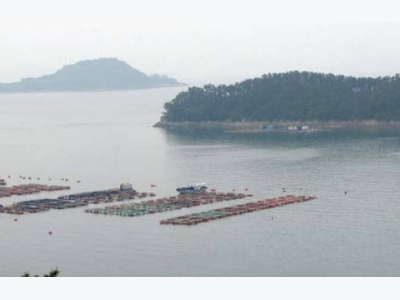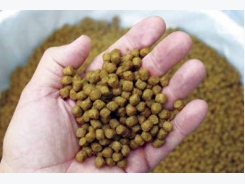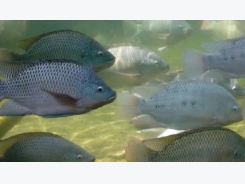Lake, Reservoir Characteristics Affect Cage Culture Potential

Factors that include area, volume and flushing rates interact to affect water quality in lakes and reservoirs.
Summary:
Culture cages should be installed in areas with good water circulation and not placed in embayments with narrow openings or very shallow water. Once stratification occurs, there is no source of dissolved oxygen to the bottom layers of water bodies until they destratify and circulate. Fish stress and mortality can result. Oligotrophic and mesotrophic lakes and reservoirs are better than eutrophic ones as sites for cage culture.
For cage culture conducted in lakes and reservoirs, good water quality is essential in assuring adequate conditions for good fish survival and growth. Moreover, only a relatively small proportion of the organic matter and inorganic nutrients in feed applied to cages is transformed to fish biomass. Waste from feeding that enters the water or settles to the bottom can accelerate eutrophication and make conditions worse for cage culture. Lakes and reservoirs can be separated into different trophic categories based upon their nutrient concentrations and phytoplankton productivity (Table 1). Oligotrophic water bodies are low in nutrient concentration, have sparse phytoplankton abundance and normally have clear water. The availability of nutrients and phytoplankton growth is moderate in mesotrophic bodies and high in eutrophic lakes and reservoirs. Waters become more turbid with increasing phytoplankton abundance.
Stratification
Lakes and reservoirs normally are deep enough to stratify thermally in response to solar radiation with warmer, lighter water in the upper stratum and cooler, heavier water in the lower stratum. The upper layer is called the epilimnion, while the lower layer is known as the hypolimnion. The layer between the epilimnion and hypolimnion, across which temperature changes rapidly, is the thermocline. The thickness of the epilimnion tends to decrease as the abundance of phytoplankton increases. As long as water bodies are stratified, they do not completely circulate, and the epilimnion does not mix with the hypolimnion. In the zone from 20 to 40° latitude, lakes and reservoirs typically stratify from spring to fall and circulate in winter. In the subtropics and tropics, water bodies stratify thermally, but may or may not circulate on a regular basis depending upon depth, surface area, wind action and differences in weather conditions from season to season. Most lakes and reservoirs in warm climates, however, experience destratification and circulation on an annual basis or at irregular intervals.
Oxygen Demand
There is sufficient light in the epilimnion to support phytoplankton productivity, but not enough light for photosynthesis reaches the hypolimnion. Thus, once stratification occurs, there is no source of dissolved oxygen to the hypolimnion until the lake destratifies and circulates. Dead plankton and other settleable solids accumulate in the hypolimnion and impose an oxygen demand.
Table 1. Water quality of lakes and reservoirs with different trophic status.
| Trophic Status | Total Nitrogen (mg/L) | Total Phosphorus (mg/L) | Chlorophyll a (µg/L) | Secchi Disk Visibility (m) |
| Oligotrophic | Below 0.25 | Below 0.005 | Below 3 | Over 6 |
| Mesotrophic | 0.25-0.50 | 0.005-0.010 | 3-15 | 2-6 |
| Eutrophic | Over 0.50 | Over 0.010 | Over 15 | Below 2 |
In oligotrophic and mesotrophic lakes and reservoirs that circulate on a regular basis, the hypolimnion contains dissolved oxygen, while the hypolimnion of eutrophic lakes becomes devoid of dissolved oxygen during stratification. Waste from cage culture also settles into the hypolimnion to increase the oxygen demand.
Dilution by oxygen-depleted, hypolimnetic water and oxidation of reduced substances that accumulate in the hypolimnion can lower or deplete dissolved oxygen throughout a lake or reservoir immediately after stratification breaks up and circulation occurs. Fish stress and mortality can result from thermal destratification of a lake with an oxygen-depleted hypolimnion.
The dissolved-oxygen concentration in the epilimnion varies with phytoplankton abundance, weather conditions and time of day. With higher phytoplankton abundance, the greater will be the variation between the daily minimum dissolved-oxygen concentration in the early morning and the maximum concentration in mid-afternoon.
In highly eutrophic water bodies, daily minimum concentrations of dissolved oxygen can fall below 2 or 3 mg/L and stress or possibly kill fish. Periods of cloudy weather can lead to low dissolvedoxygen levels even in mesotrophic lakes and reservoirs. Oligotrophic and mesotrophic lakes and reservoirs are clearly better than eutrophic ones as sites for cage culture.
Table 2. Guidelines for selecting cage sites in lakes and reservoirs.
| - Lake or reservoir should be pollution-free with low productivity. Water should be clear or mildly green with transparency of ≥ 100 cm. - No more than 50% of depth should be devoid of dissolved oxygen during periods of thermal stratification. - Water level changes should be known. Minimum depths must be at least 1 m deeper than cage bottoms. - Wind patterns and water currents should be considered. - Avoid sites with aquatic macrophyte infestations. - Security of fish in cages should be considered. |
Water Circulation
Dissolved oxygen is replenished, and ammonia, carbon dioxide and other metabolic wastes are removed from cages by water currents. Thus, the movement of water at the site where cages are installed is important.
Cages should be installed in an area with good water circulation and not placed in embayments with narrow openings, in weed beds or in very shallow water. Of course, care should be taken to install cages where they are not subject to wave damage and do not interfere with navigation.
Eutrophication
Nitrogen, phosphorus and other nutrients that result from feed input to cages can accelerate eutrophication in a lake or reservoir and threaten the culture operations. Water bodies have an ability to assimilate a certain amount of nitrogen and phosphorus from cage culture, and a portion of added nitrogen and phosphorus is discharged in outflow.
The flushing rate is the time required for an amount of water equal to the volume of a lake or reservoir to discharge. Flushing rates vary from a few weeks to many years, but the shorter the flushing rate, the faster nutrients are discharged, and the less likely nitrogen and phosphorus inputs will accelerate eutrophication. This is the reason that the Best Aquaculture Practices (BAP) standards for cage culture in lakes impose limits on feed inputs based on the flushing rates of lakes and reservoirs.
Important Factors
The most important factors to consider when seeking a site for cage culture in a lake or reservoir are the trophic status of the water body, including dissolved oxygen concentration and water temperature profiles at the peak of thermal stratification; water area, volume and flushing rate; and the physical conditions of the site. Guidelines for selecting cage culture sites are summarized in Table 2.
Producers that seek BAP certification must have accurate estimates of surface areas and flushing rates for lakes and reservoirs for use in estimating maximum feed inputs. Following BAP certification, water quality must be monitored to verify that the allowable daily feed input is low enough to avoid accelerated eutrophication.
Related news
Tools

Phối trộn thức ăn chăn nuôi

Pha dung dịch thủy canh

Định mức cho tôm ăn

Phối trộn phân bón NPK

Xác định tỷ lệ tôm sống

Chuyển đổi đơn vị phân bón

Xác định công suất sục khí

Chuyển đổi đơn vị tôm

Tính diện tích nhà kính

Tính thể tích ao









 Feed Efficiency Indicators for Responsible…
Feed Efficiency Indicators for Responsible…  Dissolved-Oxygen Requirements In Aquatic Animal…
Dissolved-Oxygen Requirements In Aquatic Animal…